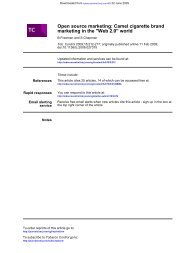National Cancer Prevention Policy - Tobacco Control Supersite
National Cancer Prevention Policy - Tobacco Control Supersite
National Cancer Prevention Policy - Tobacco Control Supersite
You also want an ePaper? Increase the reach of your titles
YUMPU automatically turns print PDFs into web optimized ePapers that Google loves.
P r i n c i p l e s o f<br />
s c r e e n i n g<br />
Screening refers to the application of a test to a population which has no overt signs or<br />
symptoms of the disease in question, to detect disease at a stage when treatment is more<br />
effective. The screening test is used to identify people who require further investigation to<br />
determine the presence or absence of disease and is not primarily a diagnostic test.<br />
The purpose of screening an asymptomatic individual is to detect early evidence of an<br />
abnormality or abnormalities such as pre-malignant changes (e.g. by Pap test) or early<br />
invasive malignancy (e.g. by mammography) in order to recommend preventive strategies<br />
or treatment that will provide a better health outcome than if the disease were diagnosed<br />
at a later stage.<br />
It is a commonly held belief among health professionals and the community that ‘early<br />
diagnosis’ of cancer is beneficial and therefore screening is bound to be effective.<br />
However, it cannot be assumed that each person who has a screen-detected abnormality<br />
or cancer within a screening program will benefit from that diagnosis. For example, it<br />
is now understood that a substantial proportion of early abnormalities on Pap tests (i.e.<br />
dyplastic changes) will regress without treatment. The potential benefits of organised<br />
population screening program for cancer must thus outweigh any potential harms that<br />
may result in the use of a screening test in people who are otherwise well (Miller 1996)<br />
and there must be strong evidence, preferably from randomised trials, that a screening<br />
program is effective in reducing mortality from cancer.<br />
Principles for the introduction of population screening<br />
The accepted criteria for the assessment of evidence on benefits, risks and costs of cancer<br />
screening are the principles adopted by the World Health Organization (Wilson & Jungner<br />
1968):<br />
•<br />
•<br />
•<br />
•<br />
•<br />
•<br />
•<br />
•<br />
•<br />
•<br />
the condition should be an important health problem<br />
there should be a recognisable latent or early symptomatic stage<br />
the natural history of the condition, including development from latent to declared<br />
disease, should be adequately understood<br />
there should be an accepted treatment for patients with recognised disease<br />
there should be a suitable test or examination that has a high level of accuracy<br />
the test should be acceptable to the population<br />
there should be an agreed policy on whom to treat as patients<br />
facilities for diagnosis and treatment should be available<br />
the cost of screening (including diagnosis and treatment of patients diagnosed) should<br />
be economically balanced in relation to possible expenditure on medical care as a<br />
whole, and<br />
screening should be a continuing process and not a ‘once and for all’ project.<br />
Recommendations for or against population screening interventions are influenced by<br />
the relative strength of the available scientific evidence in relation to these criteria. Most<br />
importantly, there should be sufficient direct evidence from well-conducted studies that<br />
122 Section Two: Screening to detect cancer early




